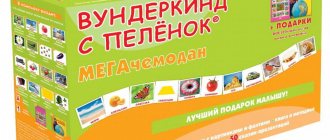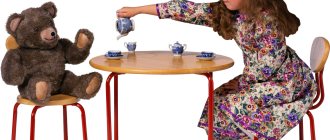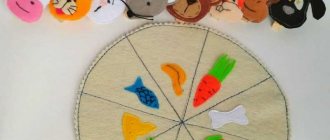MAGAZINE Preschooler.RF
The importance of design in the formation of the personality of a preschool childDesign is a purposeful process that results in a specific real product. Children's construction is closely related to play and is an activity that meets the interests of children.
Construction opens up great opportunities for shaping the comprehensive development of children and their creativity.
Construction is an important means of mental education for children. In the system of mental education, a large role belongs to the formation of the child’s sensory abilities. Sensory abilities develop most successfully in productive activities, in particular in construction. Here, sensory processes are carried out not in isolation from activity, but in it itself, revealing rich opportunities for sensory education.
Mastering construction helps expand the vocabulary and enrich children's speech, since in the process of work children share their ideas, learn to motivate them by communicating with each other, give a verbal report on the actions performed, etc. The child learns the necessary words in connection with the needs of other activities, which contributes to the formation of the correct meaning of words and ways of using them.
When constructing, the child’s visual perception of objects in the surrounding world is improved. It becomes more focused. A prerequisite is also created for acquiring the ability, already at preschool age, to carry out a deeper visual analysis of a model and an object, without resorting to real dismemberment. Thus, the ability to compare and perform visual analysis is formed, including thinking processes in the process of perception.
Sensory education aims to develop spatial concepts, and design plays a large role in this. When constructing a structure (building), the child clarifies and expands his ideas, first outlining its position in space and the location of its parts. These ideas are also improved when he creates a toy, placing and gluing small parts (decorations on the walls of a basket, windows near a house, etc.) on a flat pattern (pattern); Before folding and gluing the pattern into a finished three-dimensional toy, the structures are placed on a certain plane ( “on the street” , “on the farm”, etc.). Thus, the formation of spatial representations in the design process occurs on visual material.
In the process of constructive activity, children form generalized ideas. These generalizations arise on the basis of ideas obtained from direct perception of various structures and the creation of their own buildings. Children learn that many objects in the environment make up groups of homogeneous objects, united by one concept: buildings, bridges, transport, etc. In each group, objects have both common and different characteristics.
The formation of this kind of ideas contributes to children’s assimilation of the main constructive dependence - the dependence of the design on its practical purpose, which has a significant impact on the development of children’s thinking.
In the process of teaching children to construct different designs of homogeneous buildings or toys (a residential building, a school, a kindergarten; a box, a house, a basket), conditions are created for the development of creative design skills. The child assimilates, as it were, a scheme for making a building or a toy, transmitting both common and different characteristics into them, and carries out this in a certain sequence. This nature of the activity is the basis for allowing children to look for a way to independently produce a new version of an object, which is often required in the game.
Design is also an effective means of aesthetic education. By introducing children on excursions to some structures and buildings (residential buildings, buildings, kindergartens, schools, theaters), as well as architectural monuments accessible to their understanding (Moscow Kremlin, Bolshoi Theater, etc.), the teacher has the opportunity to develop the artistic taste of children, causing they have aesthetic pleasure when looking at beautiful buildings. To develop the ability to appreciate what people have created through creative work, to love the architectural riches of their city, country, and to take care of them.
Purposeful and systematic teaching of design to children plays a big role in preparing children for school. It contributes to the development of children’s ability to learn, reveals to them that the main meaning of activity is not only in obtaining results, but also in acquiring knowledge and skills. Such a cognitive motive causes significant changes in mental processes. These changes consist mainly in the ability to voluntarily control one’s cognitive processes (direct them to solve educational problems), to achieve a certain level of development of mental operations, and the ability to systematically perform mental work necessary for the conscious assimilation of knowledge.
| Next > |
Constructive activity is a practical activity aimed at obtaining a specific, pre-conceived real product that corresponds to its functional purpose. Design has extremely wide possibilities for mental, moral, aesthetic, and labor education.
Children's construction is usually understood as a variety of buildings made from building materials, the production of crafts and toys from paper, cardboard, wood and other materials. In its nature, it is most similar to visual activity and play - it also reflects the surrounding reality. Children's buildings and crafts are for practical use (buildings for play, crafts for decorating a Christmas tree, for a gift for mom, etc.), and therefore must correspond to their purpose.
There are two types of children's design: technical and artistic.
In technical design, children mainly display real-life objects, and also come up with designs by association with images from fairy tales and films. At the same time, they model their main structural and functional features: a building with a roof, windows, a door; a ship with a deck, stern, steering wheel, etc.
The technical type of design activity includes: design from building material (wooden painted or unpainted parts of geometric shape); from designer parts with different fastening methods; from large-sized modular blocks.
In artistic design, children, when creating images, not only (and not so much) display their structure, but express their attitude towards them, convey their character, using such a technique as “violation” of proportions, as well as color, texture, shape: a cheerful clown , a thin simpleton wolf, a handsome prince, etc., which leads, in the words of A.V. Zaporozhets, to “the formation of unique emotional images.”
The artistic type of design includes design from paper and from natural materials.
Construction is a productive activity that meets the interests and needs of preschoolers. Children use the created buildings and crafts in games, in theatrical activities, and also as gifts, decoration of premises, grounds, etc., which brings them great satisfaction.
Children's design, and especially technical, is closely related to play activities. Children build buildings (car garage, knight's castle, etc.) and play with them, repeatedly rebuilding them during the game.
Taking into account the features of play and design, their relationship is necessary when determining the forms and methods of organizing these different types of children's activities. Thus, the requirements for the quality of structures erected even by older children during role-play are unjustified, since this can destroy it. And vice versa, to be content with primitive children's buildings and crafts and not to purposefully develop full-fledged construction as an activity means to significantly impoverish the development of children.
Construction classes develop children's sensory and thinking abilities.
According to T.V. Luss, with properly organized activities, children acquire:
- constructive and technical skills:
- construct individual objects from building materials - buildings, bridges, etc.;
- make various crafts from paper - Christmas tree decorations, boats, etc.;
- generalized skills:
- purposefully look at objects
- compare them with each other and divide them into parts,
- see the common and different in them,
- find the main structural parts on which the location of other parts depends,
- make inferences and generalizations.
It is important that children’s thinking in the process of constructive activity has a practical orientation and is of a creative nature. When teaching children to design, planning mental activity develops, which is an important factor in the formation of educational activity. When children design a building or craft, they mentally imagine what they will be like and plan in advance how they will be completed and in what sequence.
According to L. A Paramonova, constructive activity contributes to practical knowledge of the properties of geometric bodies and spatial relationships:
- children’s speech is enriched with new terms and concepts (bar, cube, pyramid, etc.), which are rarely used in other types of activities;
- children practice the correct use of concepts (tall - low, long - short, wide - narrow, large - small), in precise verbal indication of direction (above - below, right - left, down - up, behind - in front, closer, etc.). d.).
Constructive activity is also a means of moral education of preschool children. According to L.A. Wenger, in the process of this activity important personality qualities are formed:
- hard work,
- independence,
- initiative,
- perseverance in achieving goals,
- organization.
Joint constructive activities of children (collective buildings, crafts) play a big role in developing the initial skills of working in a team:
- the ability to negotiate in advance (distribute responsibilities, select the material necessary to complete a building or craft, plan the process of their manufacture, etc.);
- work together without interfering with each other.
However, constructive activity acquires such a multifaceted significance in raising children only if systematic training is carried out and a variety of methods are used aimed at developing not only constructive skills, but also valuable qualities of the child’s personality and mental abilities.
Construction in kindergarten
| According to the terms | In the process of such construction, children develop the ability to analyze conditions and, on the basis of this analysis, build practical activities of a rather complex structure. Children just as easily and firmly learn the dependence of the structure of a structure on its practical purpose and in the future can themselves - based on the establishment of such a dependence - determine the specific conditions to which their construction will correspond, create interesting ideas and implement them |
| By design | Creating a plan for a future design and its implementation is a rather difficult task for preschoolers: their plans are unstable and often change in the process of activity. It is necessary to develop the desire to build according to your own plans, combine buildings according to the plot, play with them, encourage them to play together |
| On this topic | Children are offered a general design theme (“Birds”, “City”, etc.), and they themselves create plans for specific buildings, crafts, choose the material and methods of their implementation |
Tasks in teaching and guiding children's constructive activities
:
To develop in children the necessary skills and design skills.
To give children knowledge about objects displayed in constructive activities, about their appearance, structure, main parts, shape, spatial arrangement, relative size, about the materials with which they work.
Children should be able to group objects according to their common characteristics and understand the relationship between the features of their shape and the functions they perform.
Determine the texture of paper (whatman paper, glossy color, writing), know thin cardboard, wire in an insulating winding, etc. Know their properties and possibilities of use. Children should be able to use paste, stationery and wood glue when gluing various materials.
Teach children to work purposefully and pre-plan their activities, which is a necessary condition for the successful completion of constructive tasks.
To foster in children independence in work and creative initiative.
To develop the ability to control one’s activities, to direct it towards a more rational path to solving the problem proposed by the teacher. To teach to understand that the purpose of design classes is not so much a practical result as the acquisition of new knowledge and skills, that is, to develop in children the ability to learn and readiness to study at school.
It is also necessary to use the rich opportunities for constructive activities to instill in children a sense of teamwork at work.
Basic techniques for teaching design
What are the benefits of robotics for children?
The benefits of this science are undeniable!
By constructing robots, your child:
1. DEVELOP:
- responsibility;
- discipline;
- creative thinking;
- imagination;
- speech and mental abilities;
- attentiveness;
- patience;
- determination;
- perseverance;
- memory;
- fine motor skills of the hands.
2. WILL LEARN:
- work in a team;
- act step by step from simple to complex;
- good spatial orientation;
- make decisions independently;
- respect other people's work;
- bring the work started to its logical conclusion.
3. MASTER:
- basics of computer literacy;
- fundamentals of mathematics and physics;
- working with mechanisms;
- design and construction;
- diversity of the surrounding world;
- communication skills with teachers and peers;
- English (after all, most programs and educational texts are presented in English).
Children who have attended robotics classes from an early age will in the future much more easily master such serious disciplines as programming, physics, and engineering. The reason for this is that the simplest construction in childhood gives an understanding of how the particular relates to the whole, how to assemble a working product from small particles. In the future, such an intuitive skill will serve a person well.
What is robotics?
Robotics is a science that studies the design and use of automated technological systems, or simply robots. There is an opportunity for children to study robotics in schools and in additional education sections. Robots are created using special constructors. Children are easily involved in this process, because creating a robot on their own, and most importantly, getting the result, is extremely interesting.
A big plus is also the nuance that the classes combine both knowledge and entertainment, and therefore are becoming increasingly in demand among children and their parents.
If your child shows a sincere interest in technology, pay attention to robotics; in the process of studying, he will learn many useful skills, become more independent, active and believe in himself.
Fraza.ua - the author's view of life
A construction set is a universal educational toy that effectively influences a child’s thinking and creative abilities. Let’s find out from the experts of the online store “Budinok Igrashok” how construction is useful for a child’s development.
The uniqueness of the designer is that it is a complex toy that simultaneously stimulates the intellectual, psychophysiological and emotional development of the child and instills in him the necessary skills. The benefits of a passion for construction affect multiple aspects of the personality and are long-lasting. It has been proven that a child's passion for construction toys affects future success in school and in adult life.
Logic and math skills
Numerous studies by American and Dutch scientists have revealed a direct connection between a love of construction toys and success in mathematics. It turned out that the better a child copes with construction, the better he masters counting and solves mathematical problems. The fact is that during modeling, kids have to rely on basic logical techniques (analysis, synthesis, comparison, generalization, etc.), which develops thinking, logic and intelligence - what is necessary for the successful mastery of mathematics and other exact sciences .
Imagination and spatial thinking
By constructing from cubes and other elements, children think through the composition and learn to see objects three-dimensionally. This develops spatial thinking, which in turn helps to master geometry, drawing and various types of visual art. Having learned to navigate in three-dimensional space, kids gradually move away from the instructions, turn on their imagination and imagination, and begin to model their own worlds. Thus, they learn to think outside the box and approach the process creatively. This is how creativity is born in a child.
Patience and self-discipline
Assembling models, especially complex ones, takes time, so construction instills in children perseverance and patience. Focusing on results requires self-discipline. Children become calmer, more purposeful and independent, learning to cope with tasks on their own, which in the future helps them find a way out of life’s difficulties.
Fine motor skills and speech
Block, screw, and magnetic constructors require the child to interact with small parts. To connect the elements of a modeled object with each other, children have to perform precise actions with their hands and fingers. This develops fine manual motor skills, which is especially important at an early age, when movements are still poorly coordinated and the fingers are reluctant to obey the little owner. In addition, the centers that control manual motor skills and speech are located nearby in the brain, therefore, by developing hands, the child simultaneously stimulates speaking skills. His speech becomes clearer and more correct. It is no coincidence that construction toys are used in the treatment of speech disorders and autism.
Knowledge of the world and socialization
Typically, children assemble familiar objects from construction kit parts: buildings, vehicles, animals, etc. This helps to update knowledge about the world around them and deepens their understanding of reality. If at the same time the kids work in a team, they get to know each other better, establish friendly connections, help and support their comrades in working for a common result. The communication skills developed in this way in the future help children to socialize in any group.
Child psychologists say that the best toy is one that can change in unpredictable ways. In this sense, there is little that can compete with the designer. It was originally conceived as going beyond the template. A construction set cannot replace all the toys a child has, but with the right approach, it can be used to harmonize and positively influence child development.
Open up a wonderful world of fantasy and design for your child.
Read the Phrase on Google News (click “Subscribe”)
Subscribe to Fraza channels on Telegram, Youtube, Twitter, Instagram, Facebook
Which designers to choose?
Designers for classes are selected in accordance with the educational program and the age of the child. They can be either domestic or foreign made. For preschoolers, everyone's favorite Lego is recommended - it is easy to assemble, it contains parts in bright colors, which causes sincere delight in the smallest designers.
The Fischertechnik kit is also suitable for younger schoolchildren and beginners - its plus is the presence of real wires and plugs that create the feeling of adult programming.
At the age of fourteen, teenagers prefer more complex models that require programming skills. This is TRIC or Raspberry.
Constructive - modeling activities in preschool educationconsultation
Consultation for preschool teachers
Topic: Constructive and modeling activities in preschool educational institutions
1. Modeling as a means of developing constructive activity.
The famous Swiss psychologist Jean Piaget noted that at three years old children distinguish between open and closed figures and correctly reproduce the ratio of the sizes of two drawn circles.
By the age of four, children learn to construct a straight line using beads or buttons if they are given a ruler to guide the line they are creating.
At six or seven years old, a child can already confidently build a straight line on his own. Children at this age already understand well that one object can look different from different points of view and begin to coordinate different possible perspectives.
In older preschool age, there is a transition to the stage of formal operations, which is associated with a certain level of development of the ability to generalize and abstract, and readiness for modeling.
Modeling is the process of making a model of an object according to a drawing. Modeling brings great benefits to future schoolchildren, because the production of models contributes to a deeper understanding of the school mathematics course and the material that is being studied. By modeling, the child acquires useful practical skills, learns to build, glue, and make a drawing. After all, any model is made according to a specific drawing.
A drawing is a kind of graphic language, such a language is international. Anyone can understand it. The word “drawing” is originally Russian. In a meaning close to modern, i.e. as an image of some objects on paper, a plan of something, the word “drawing” has been used in Russian at least since the 16th century.
Constructive activity and its meaning
The term “construction” (from the Latin word construere) means bringing various objects, parts, elements into a certain relative position. Children's construction is usually understood as a variety of buildings made from building materials, the production of crafts and toys from paper, cardboard, wood and other materials. In its nature, it is most similar to visual activity and play - it also reflects the surrounding reality. Children's buildings and crafts are for practical use (buildings for play, crafts for decorating a Christmas tree, for a gift for mom, etc.), and therefore must correspond to their purpose. Construction is one of those activities that are of a modeling nature. It is aimed at modeling the surrounding space in its most essential features and relationships.
This specific focus of design distinguishes it from other types of activities.
Constructive activity is a practical activity aimed at obtaining a specific, pre-conceived real product that corresponds to its functional purpose. A characteristic feature of the design process is the recreation and transformation (combination) of spatial representations (images), which contributes to the practical knowledge of the properties of geometric bodies and spatial relationships.
In this case, the development of spatial imagination and imaginative thinking is especially important (N.N. Poddyakov). On the one hand, this type of activity requires children to have rather complex spatial orientation. The child needs to imagine the structure being created as a whole, take into account its spatial characteristics, the relative position of parts and details. On the other hand, it is in design, like in no other activity, that spatial orientations are formed. The idea of space is made up of specific features of the shape, size, length, volume of objects, as well as their structural units: parts, details.
There are two types of design: technical and artistic.
Technical design includes construction from building materials (wooden painted or unpainted parts of geometric shapes), from construction parts with different methods of fastening, from large-sized modular blocks, some methods of construction from paper, cardboard, boxes, reels and other materials; to the artistic - design from natural and waste (used) materials, from paper. Some authors classify artistic design as manual labor.
In order to develop children's design as an activity in the process of which the child develops, various forms of organization of learning are used (research by Z.V. Lishtvan, V.G. Nechaeva, L.A. Paramonova, N.N. Poddkova)
1. Design according to a sample.
Its essence: children are offered samples of buildings made from construction kit parts and shown how to reproduce them. Design based on a model, which is based on imitative activity, is an important learning stage where you can solve problems that ensure the transition to independent search activity of a creative nature.
Within the framework of this form, tasks are solved that provide a transition to independent search activity that is creative in nature. Visual and figurative thinking develops.
2. Design according to the model.
Its essence: as a sample, a model is proposed in which its constituent elements are hidden from the child. Children must reproduce this model from the construction kit parts they have.
In other words: a specific problem is proposed, but not a method for solving it. As a model, you can use a structure covered with thick white paper. Children reproduce it from an existing builder. Generalized ideas about the constructed object, formed on the basis of analysis, will have a positive impact on the development of analytical and imaginative thinking. Model-based design is a more complex type of model-based design.
3. Design according to conditions is of a different nature. Without giving children an image of the building, drawings and ways to reproduce it, they only determine the conditions that the building must meet. In the process of such construction, children develop the ability to analyze conditions and, based on the analysis, build practical activities of a rather complex structure. This form of education develops creative design, but only if the children have certain experience.
4. Design on the topic. Children are offered a general theme of structures, and they themselves create plans for specific buildings, choose the material and methods of their implementation. The main goal of constructing on a given topic is to consolidate knowledge and skills.
5. Design by design: This is a creative process in which children themselves have the opportunity to demonstrate independence. However, the teacher must remember: the design concept and its implementation is a rather difficult task for preschoolers. The degree of independence and creativity depends on the level of knowledge and skills.
6. Frame construction. When children become familiar with the simple construction of a frame and, as a result, easily grasp the general principle of constructing a frame and learn to identify design features based on a given frame.
In a design of this type, the child must, as it were, complete it, adding additional details to the same frame. It develops imagination. However, the organization of this form of design requires the development of special design material. Such as the German designer “Quadro”.
7. Design using simple drawings and diagrams. This form has a modeling character and makes it possible to introduce children to drawings and diagrams. Ability to use templates and subsequently see details in three dimensions. As a result of such training, children develop imaginative thinking and cognitive and creative abilities.
Each of the considered forms of organization of design training has a developmental impact on certain abilities of children, which together form the basis for the formation of creativity.
In order for a creative personality to develop, a subject environment in the group must be created, material and the teacher’s ability to guide and develop the child’s abilities are necessary.
The role of the designer in the life of a child
Kristina Tarasova
The role of the designer in the life of a child
Central "Swifts"
The role of the designer in the life of a child.
The child plays constantly. After all, play is the main way of perceiving information, surrounding reality, and behavior patterns.
Through play, the child understands how everything should be arranged. One of the options for an exciting, educational and educational game is a children's construction set .
Playing with a constructor promotes the development of fine motor skills, ideas about color and shape, and orientation in space. This combination of various types of influences has a beneficial effect on the development of speech, facilitates the assimilation of a number of concepts and even the production of sounds, since the development of fine motor skills has a stimulating effect on the development of speech motor areas of the cerebral cortex.
Games with a constructor can be organized according to the type of constructive-creative game , plot-role-playing game and other types of games. The type and features of the game depend on the level of preparedness of the group of children, its characteristics, as well as didactic and speech goals.
When turning to the capabilities of the designer , we can note some advantages of its use over other, traditional types of work that develop fine motor skills, such as drawing, modeling or appliqué.
- Firstly, only with construction can a child play, touch them, without the risk of spoiling them, while drawings, appliqués or plasticine figures cannot be suitable for organizing play.
— Secondly, when using a construction set , a child can create colorful and attractive crafts, regardless of his or her existing skills. The child is already experiencing a mental state of success.
— Thirdly, since the construction set can be placed not only on the table, but also on the floor, on the carpet, the child does not need to maintain a static sitting position during classes, which is especially important for somatically weakened children.
— And finally, the designer is safe , and you can remove the crafts quickly and easily.
Working with the designer and , in particular, games can be used for various purposes:
— Development of fine motor skills of the hands.
— Development of speech within certain topics.
— Automation of sounds during the game.
— Development of ideas about color, shape, space.
— Development of quantitative concepts.
— Creating conditions for natural, full-fledged communication between children during joint work.
- Uniting the team of children, developing a sense of empathy for each other.
Despite the growing popularity of computer games, construction sets are indispensable for children's development. The child acts with parts of building materials, construction sets , repeatedly compares them, selects them, tries them on, manipulates them, makes mistakes and corrects mistakes. Through practical experimentation the result is obtained. And the more the child performs trying actions, the faster he begins to rely on visual perception and do without constant preliminary trying actions, and finds new techniques to achieve results.
Currently, special attention is paid to design
Construction is one of the most favorite children's activities. It is not only exciting, but also useful for the child. Construction creates the necessary foundation for the comprehensive development of the child. It promotes the formation of imaginative thinking and a sense of beauty, imagination and dexterity, attention and determination.
First of all, construction is considered one of the most important means of mental education. It focuses on a holistic perception of the future building, teaches observation, the ability to generalize, compare, and analyze. Games with blocks expand the child’s mathematical understanding of the shape, size, spatial and quantitative relationships of objects. Classes with the designer contribute to the development of personal values, such as determination, accuracy, organization and responsibility. The constructor will become a faithful assistant in preparing children for school, developing their speech, memory and independence. Another important thing is that the child begins to realize the need for knowledge about the subject in order to successfully construct its model . Thus, a very important need for children appears - for new knowledge about the world around them.
Design is creation , and this, in turn, implies creative search. Even building a model according to a diagram, according to psychologists, helps develop children's creative abilities. The process of correlating the model and the original requires effort, labor of thought, encourages the search for new solutions, and awakens the imagination. "Construction Games"
allow you to bring
any childhood fantasy life Here it is appropriate to recall the words of the famous Russian teacher K. D. Ushinsky: “... the best toy for a child is the one that he can force to change in the most diverse ways...”. The ability to see the whole before the parts, together with a creative approach to design , cultivates in the child a sense of beauty and composition, and forms an understanding of proportion, scale, rhythm and measure.
Construction is also of great importance for the formation of correct speech and writing in the future, because it contributes to the development of fine motor skills of the hands. To develop a child's motor skills, it is very useful to assemble various objects from blocks of children's educational construction sets . I think there is no need to explain that fine motor skills determine how well not only the child’s speech and thinking will be developed, but even his handwriting. Beautiful handwriting happens only to those whose hands are able to deftly handle small details.
Today there are many different types of constructors :
1. The simplest construction toys in children’s lives are cubes. They not only captivate children, but also help develop spatial imagination, introduce them to the shapes of objects, and form color perception. To begin with, an adult will build from cubes, and a child will simply be happy to destroy these buildings. But this is only at the beginning. Just wait a little and the buildings become more and more complex.
2. Children's construction sets in the form of figures - inserts are plastic or wooden sets in which each figure is inserted into its own hole. This type is quite difficult for a child. It helps to develop logical thinking, since before assembling the child needs to mentally compare the various figures and understand what goes where.
3. A construction set for children in the form of a mosaic comes in two types: a large mosaic, in the form of large plastic hexagons, for which there is a mold with special recesses, and the second option is a regular mosaic, which is better than the first for promoting the development of coordination of movements, but is more difficult for children. This construction set teaches the child to work with small objects, develops color perception and imagination.
4. Large block construction sets have parts of the most varied shapes and colors, there are even parts with wheels, carriages, etc. You can build almost anything from it: houses, ships, airplanes. designs are growing and becoming more complex along with him . Helps develop creative thinking, color perception, combinatorics, spatial imagination and many other skills.
5. Lego construction set for children
Available in a wide variety of types, for children of all ages. The child will never get tired of it, since you can use it to assemble a wide variety of things: houses, cars, transformers, toys on microscopic chips and much more. Helps develop fine motor skills and mental activity.
6. There are also wooden and magnetic construction sets . For wooden ones, only very high-quality types of wood are used; assembling them is very difficult and exciting; the use of glue is often necessary. From it, the child will be able to assemble wooden toys or buildings. They help develop engineering and design abilities , accuracy and attention. Magnetic ones come in the form of various sticks, plates and metal balls. In addition to being an interesting game, they help you get acquainted with the properties of magnets.
All of them help the child develop imagination, train spatial thinking and fine motor skills, cultivate perseverance and concentration.
The child goes from simple to complex, creating new buildings, ships, aircraft and robots. A children's construction set trains perseverance, develops imagination, and teaches creative work.
Children's construction sets allow you to learn everything: from the names of objects to the creation of these very objects.
Thanks to the constructor, the child develops object activity - performs actions with the object according to its intended purpose. With the help of an adult, the child learns the names of various figures and objects that remain unchanged and do not depend on various life situations . At the same time, the child can try to use these objects not only for their intended purpose, but also experiment, thus the child also develops creative abilities. In this game, he learns to practically master the concept of geometric figures, shapes, sizes, and the relationship between figures that are different in size but, for example, identical in shape. Thanks to the designer, the child develops coordination, as well as fine motor skills, which contributes to the development of speech. Through the contact of an object with the hand, the child learns to feel the difference in objects, developing kinesthetic sensitivity.
When and which designer to buy?
Children's construction sets are usually divided into groups according to the age of the children.
Construction set for children from 1 to 4 years old
At this age, it is better to choose a construction set that contains a small number of large parts to prevent the baby from swallowing them.
The process of playing with a construction set at this age is limited to building tall towers (and parents will have to do this at first to show the child the principle of the game). When the child grows up a little, he will happily build them himself. All you need to do is encourage your baby in his endeavors!
Construction set for children from 4 to 7 years old
At this age, a child can already concentrate his attention on the game for a long time and assemble more complex construction sets, but not yet without the help of his parents. Tell your child what is best to combine with what so that the end result looks like in the picture.
Pay attention to the Lego Duplo brand - this is a type of Lego construction set designed specifically for preschool children. The details in the designer are large, the plots are simple. It will be interesting for your child to assemble such a set and play with it after assembly.
Construction set for ages over 7 years
At this age, children are already ready and want to assemble more complex construction sets that represent some kind of plot and consist of a large number of different parts. For example, Lego designers have a lot of interesting sets: a pirate ship (with real pirates, treasures in chests and other paraphernalia), an underwater world, a princess’s palace and others.
You can also offer older children an iron construction set (Meccano), the parts of which are connected with special bolts and nuts. From them you can assemble entire models of trains, cars, buildings!
We think you are convinced that the construction set is an excellent educational toy, and the large assortment allows you to choose it for children of any age.
If you liked the article, please share a link to it






